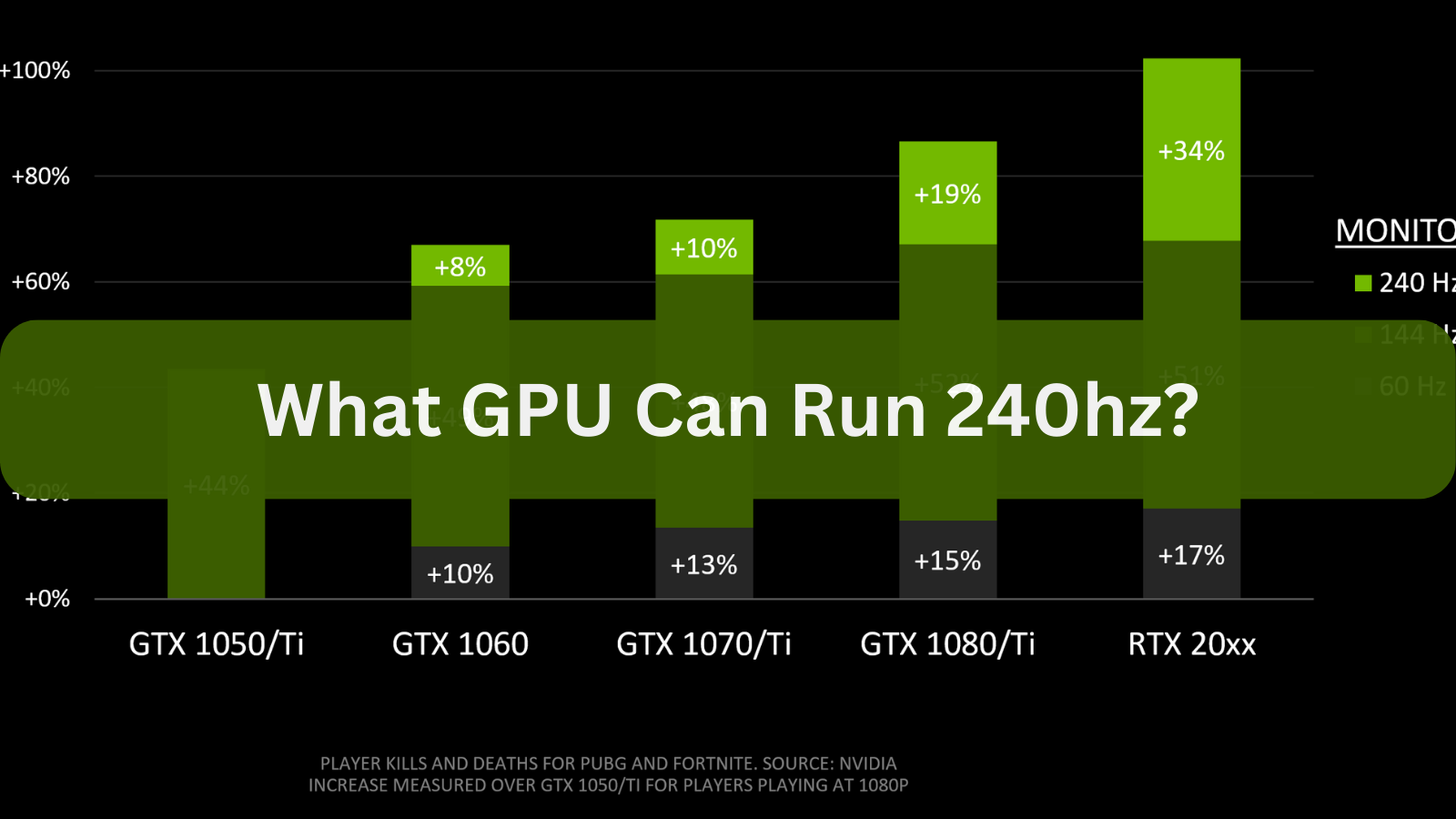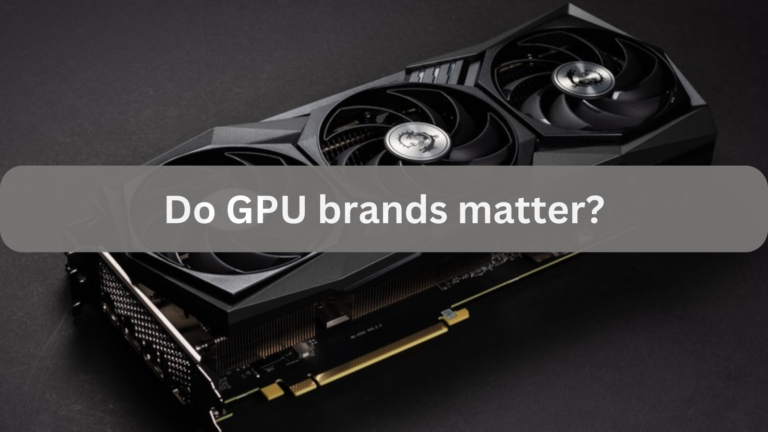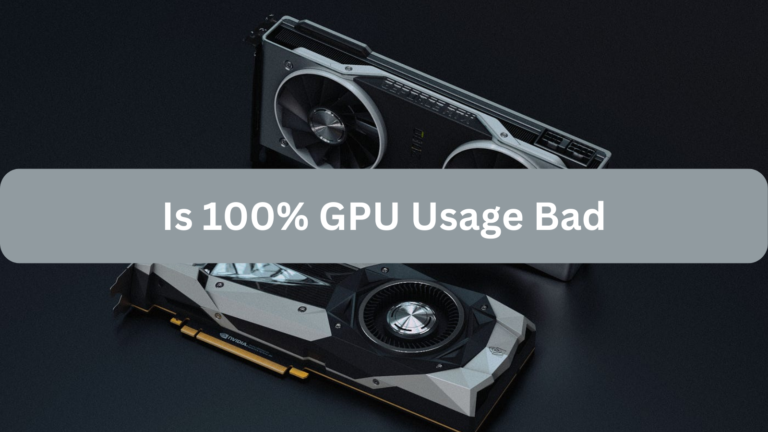What GPU Can Run 240hz? Ultimate Guide – 2024
Achieving a 240Hz refresh rate in gaming is the ultimate goal for incredibly smooth, immersive visuals, but it takes a powerful GPU to make it happen.
A top-tier GPU, such as the AMD Radeon RX 6800 XT/6900 XT or NVIDIA GeForce RTX 3080/3090, is required to run a 240Hz monitor smoothly. These GPUs are capable of handling demanding games at high frame rates, resulting in a smooth and engaging gaming environment.
Find out which GPUs are best suited to run a 240Hz display for incredibly fluid, flawless gaming.
Also Read: Is 50 Celsius Hot For A GPU?
What GPU is best for 240 FPS 1080p?
The best GPUs are usually high-end ones with tremendous performance, able to achieve 240 FPS at 1080p. Both the AMD Radeon RX 6800 XT and the NVIDIA GeForce RTX 3080 or RTX 3070 are great options.
When combined with a powerful CPU and well-configured settings, these GPUs can manage demanding games at high frame rates. These GPUs are perfect for competitive gaming, where a high frame rate is essential, as they guarantee fluid gameplay and responsiveness at 240 FPS.
What GPU is best for 240 FPS 1440p?
The AMD Radeon RX 7900 XTX and NVIDIA GeForce RTX 4080 are excellent options for attaining 240 FPS at 1440p resolution. With their remarkable performance, these GPUs are ideal for 1440p high-refresh-rate gaming.
Their high clock speeds, effective cooling systems, and abundance of CUDA cores or stream processors enable them to run demanding games at high settings and still retain fluid frame rates. Their cutting-edge features, like high-bandwidth RAM and DLSS (Deep Learning Super Sampling), significantly improve gaming performance and visual quality.
What GPU can run 4K at 240 Hz?
A very potent GPU, such as the AMD Radeon RX 7900 XTX or the NVIDIA GeForce RTX 4090, is needed to run 4K at 240 Hz.
When playing less demanding games or with adjusted settings, these top-tier GPUs are especially well-suited to manage the enormous bandwidth and processing demands of 4K resolution at such high refresh rates.
Achieving 240 Hz at 4K, however, is difficult and can need sacrificing graphics quality or playing some less resource-demanding games.
Differences Between 60Hz, 144Hz, and 240Hz
The responsiveness and motion smoothness of 60Hz, 144Hz, and 240Hz refresh rates differ mostly from one another. While this is plenty for simple tasks, a 60Hz display refreshes the image 60 times per second, which can cause choppy gameplay in fast-paced games.
For competitive gaming, a 144Hz panel is a clear improvement as it offers considerably smoother motion and better responsiveness.
This experience is further enhanced by a 240Hz display, which offers the smoothest motion and shortest response time. However, the advantages are most apparent to individuals with highly competitive circumstances or those with great perceptive talents.
Best Graphics Cards for 1080p 240Hz Gaming in 2024 Round-Up
For 1080p 240Hz gaming in 2024, top graphics cards include the NVIDIA GeForce RTX 4080, RTX 4070 Ti, and AMD Radeon RX 7900 XT. The RTX 4080 provides exceptional performance with its high core count and advanced features like DLSS 3.0.
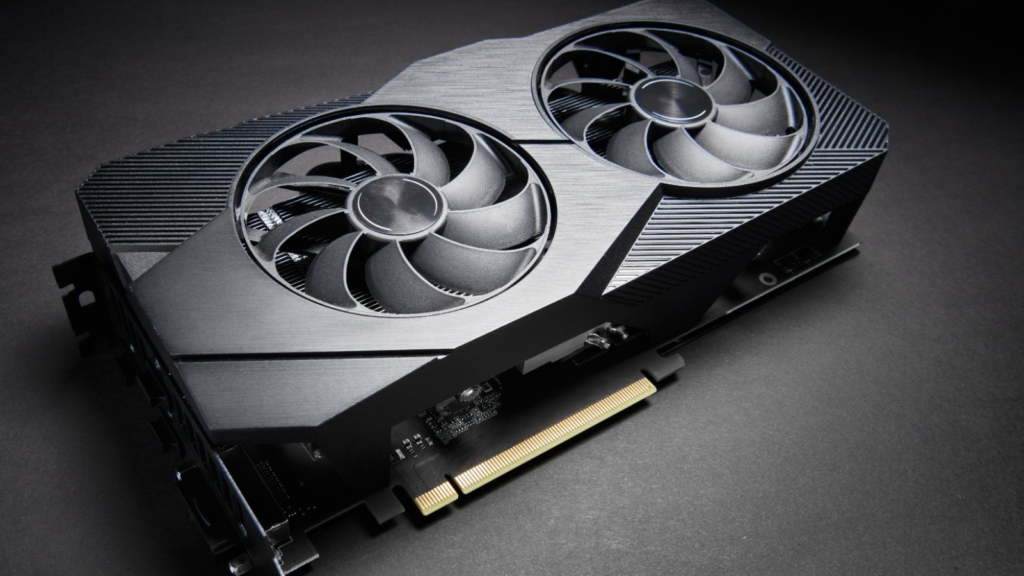
The RTX 4070 Ti offers a balance of power and value, capable of handling 240Hz gaming at high settings. The RX 7900 XT from AMD also delivers strong performance and competitive pricing.
These GPUs ensure smooth gameplay, high frame rates, and excellent visual quality, making them ideal for high-refresh-rate 1080p monitors.
Read Also: Is 82 Degrees Hot For GPU?
Is 144Hz to 240Hz noticeable?
Indeed, there is a discernible difference between 144Hz and 240Hz, especially in intensely competitive gaming. When compared to a 144Hz display, which refreshes the screen 144 times per second, a 240Hz monitor offers smoother motion and less motion blur.
Fast movements and quick reflexes can feel more fluid and accurate because of this increased refresh rate, which can also increase responsiveness and clarity. This distinction is especially helpful for competitive or fast-paced gamers since it can offer a tiny advantage in terms of reaction time and visual fluidity.
Best Budget GPU for 240 Hz
The NVIDIA GeForce RTX 3060 Ti is a notable GPU if you’re looking for something affordable that can play games at 240 frames per second. It is suitable for 240Hz monitors since it provides good performance at 1080p and can reach high frame rates in many games.
Another excellent choice is the AMD Radeon RX 6700 XT, which offers fair pricing and good performance in high-refresh-rate applications. Both GPUs are excellent options for gamers who want to get the most out of their 240Hz gaming without going over budget because they offer a good mix of performance and price.
Can RTX 3060 TI run 240Hz?
It is possible to run games at 240 Hz on the NVIDIA GeForce RTX 3060 Ti, especially in 1080p resolution. It can produce high frame rates in many games, thus even while it might not reach 240 frames per second in every game, it is still a suitable fit for a 240Hz panel.
Depending on what the particular game requires, settings may need to be changed for the optimal experience.
What graphics card is needed to run a 240Hz monitor G Sync?
To run a 240Hz G-Sync monitor effectively, a high-performance graphics card is necessary. The NVIDIA GeForce RTX 4080 or RTX 4090 are excellent choices, as they provide the power needed to consistently achieve high frame rates and take full advantage of the 240Hz refresh rate.
For a more budget-friendly option, the RTX 4070 Ti also offers strong performance and supports G-Sync. These GPUs ensure smooth and tear-free gaming experiences by synchronizing with the monitor’s refresh rate and handling the high demands of fast-paced games.
What GPU do you need for 1440p 240Hz?
A powerful GPU is needed to handle the high frame rates and resolution needed to get 1440p @ 240Hz. These are great options: the AMD Radeon RX 7900 XTX, the NVIDIA GeForce RTX 4080, and the RTX 4090.
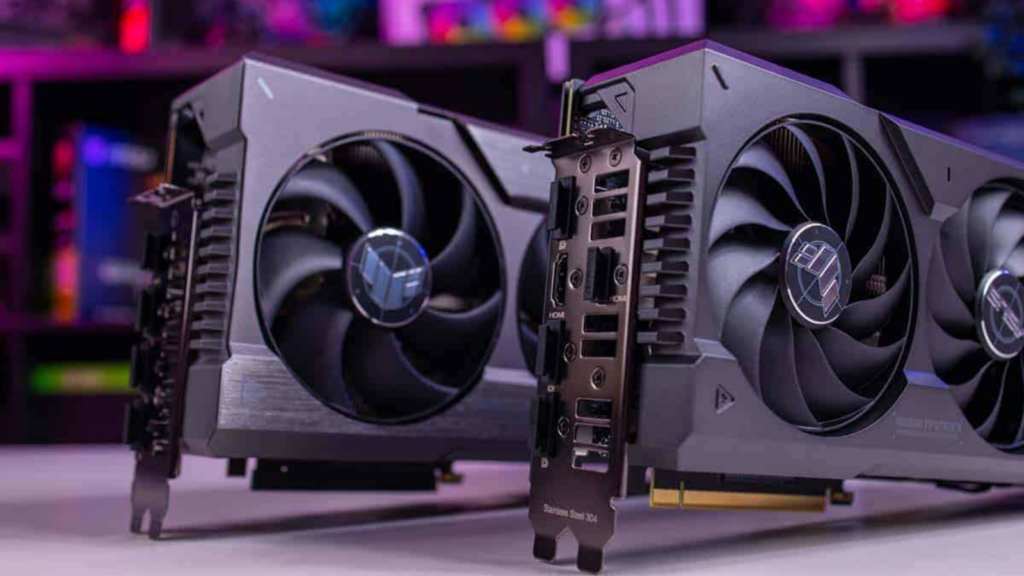
The performance of these GPUs enables the achievement of high frame rates at 1440p, guaranteeing fluid and responsive gaming. When playing demanding games and competitively, these cards will make sure you can fully utilize a 1440p 240Hz panel.
Read More: What Temp Does GPU Fan Turn On?
Can an RTX 3070 Handle 240Hz?
Although the NVIDIA RTX 3070 can support 240Hz screens, game settings, and resolution will affect how well it performs. In many games, the RTX 3070 can achieve or surpass 240 frames per second at 1080p, which makes it a good choice for high-refresh-rate monitors.
At 1440p, meanwhile, it would be difficult to regularly get 240Hz in the most demanding games without reducing some settings. Especially at higher resolutions, better GPUs like the RTX 3080 or RTX 4090 may be required for maximum performance at 240Hz.
Which Graphic Card Is Necessary to Operate at 240Hz?
To operate at 240Hz, especially for demanding tasks like gaming at high resolutions, a powerful graphics card is essential. The NVIDIA GeForce RTX 4080 and RTX 4090 are top choices, offering the performance needed to consistently drive high frame rates and fully utilize a 240Hz monitor.
For a more budget-conscious option, the RTX 4070 Ti can also handle 240Hz effectively, provided it’s paired with a high-refresh-rate display. These GPUs ensure smooth gameplay and optimal performance by handling the high frame rates required for a 240Hz refresh rate.
Tips For Maximizing GPU Performance At 240Hz
Make sure that everything is balanced and tuned in your system to get the most out of the GPU at 240Hz. First, make use of a high-refresh-rate display and a high-performance GPU that is compatible, like the AMD RX 6800 XT or NVIDIA RTX 3080.
Update your drivers to the most recent version to take advantage of bug fixes and performance improvements. Turn on hardware-accelerated game features and modify in-game settings (e.g., reducing graphical elements) to emphasize performance.
In order to avoid thermal throttling, make sure your system has enough cooling and ventilation. Finally, if you’re comfortable with it, think about overclocking your GPU. Just be careful to do so responsibly to prevent overheating and unstable system performance.
Understanding GPU Requirements For 240Hz Gaming
Your GPU needs to continuously produce high frame rates to match the refresh rate of the panel in order to play games at 240Hz. This calls for a strong graphics card that can manage demanding processing loads, especially at high detail and resolution settings.
Seek for GPUs like the AMD RX 6800 XT or NVIDIA RTX 3080 that can run contemporary games at high settings and consistent frame rates. To prevent bottlenecks, the GPU should be combined with a quick processor and enough RAM.
Make sure the GPU is compatible with the G-Sync or FreeSync technologies on the monitor in order to minimize screen tearing and preserve fluid gaming. Maintaining drivers up to date and controlling temperature are also essential for peak performance.
Best GPU for a 1080p 240Hz
The NVIDIA GeForce RTX 4080 is a great option for a 1080p 240Hz monitor since it has enough power to easily reach high frame rates. Another excellent option that manages 240Hz gaming well and strikes a mix between performance and cost is the RTX 4070 Ti.

The RTX 4070 is a more affordable choice that nevertheless provides high frame rates at 1080p, making gaming fluid and responsive. These GPUs are perfect for high-refresh-rate gaming because they can fully utilize the potential of a 1080p 240Hz panel.
Also Read: What Happens When GPU Overheats?
Frequently Asked Questions FAQs:
Q.1 What GPU do I need for 240fps?
An AMD RX 6800 XT or NVIDIA RTX 4070 Ti is suggested for 1080p at 240 frames per second.
Q.2 Can RTX 4070 run 240Hz?
Depending on the game and settings, the RTX 4070 can run at 240Hz at 1080p and 1440p resolutions.
Q.3 What specs do you need for 240Hz?
A strong GPU, such as an RTX 3070 or above, a high-refresh-rate monitor, and a CPU capable of keeping up, such as an Intel i7 or Ryzen 7, are required for 240Hz.
Q.4 Can RTX 2070 Super run 1440p 144Hz?
Indeed, most games support 1440p at 144Hz with the RTX 2070 Super, especially on medium to high settings.
Q.5 Can Any GPU Run 240Hz?
Not all GPUs are capable of handling 240Hz to do so successfully, especially at higher resolutions, you’ll need a high-performance GPU like the RTX 3070 or higher.
Q.6 What is the best GPU for a 240Hz monitor?
The RTX 3080 or RTX 4080, which provides outstanding performance for high-refresh-rate gaming, is the best GPU for a 240Hz display.
Q.7 Can RTX 3080 handle 240Hz?
Certainly, especially at 1080p and 1440p resolutions, the RTX 3080 can manage 240Hz.
Q.8 What graphics card can run 240 fps on Fortnite?
With 1080p settings, Fortnite can run at 240 frames per second with an RTX 3080 or higher.
Q.9 Do I need a powerful GPU for a 240Hz monitor?
Indeed, achieving high frame rates that correspond to the refresh rate of a 240Hz panel requires a strong GPU.
Q.10 How do I know if my GPU supports 240Hz?
If your GPU is capable of supporting the refresh rate, you will be able to choose it in your display options. If not, check its specs or connect it to a 240Hz monitor.
Read More: Torch is not able to use GPU
Conclusion:
You need a strong GPU that can continuously push high frame rates while looking for a GPU to operate a 240Hz panel, especially in demanding games. GPUs such as the AMD Radeon RX 6700 XT or NVIDIA RTX 3060 Ti are good options for 1080p gaming.
More powerful GPUs like the RTX 3070, 3080, or 4070 are advised to maintain 240Hz at higher resolutions like 1440p or 4K.
Your choice of GPU also relies on the kind of games you play graphics-intensive games demand more powerful GPUs. To make full use of the 240Hz experience, be sure your system supports the high refresh rate and that your GPU is paired with a suitable CPU.
